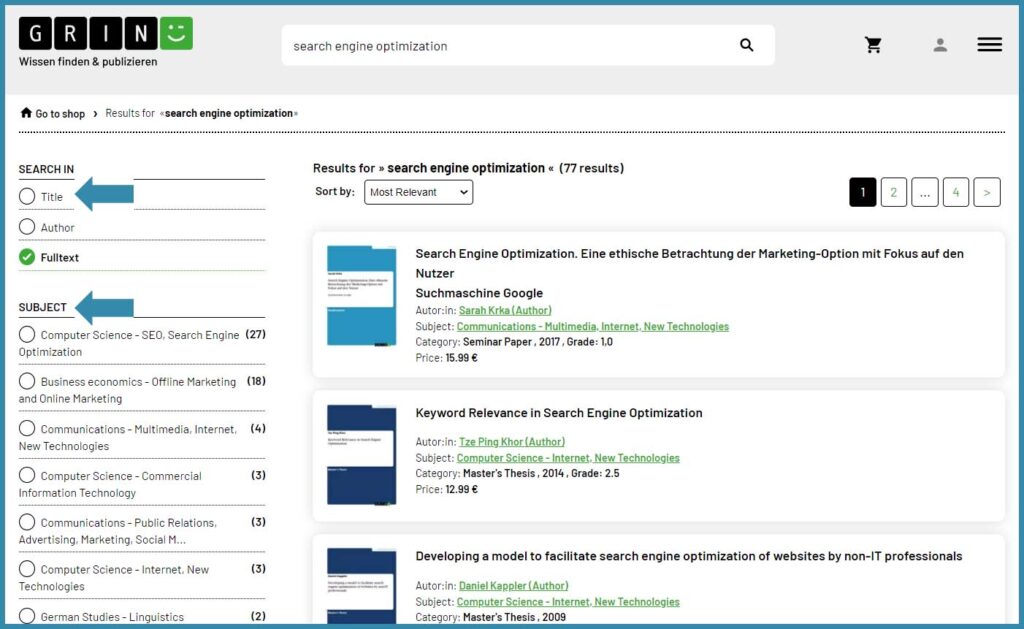First things first:
- Use both online and offline resources for your research.
- The snowball method can help you find new literature.
An academic paper not only presents your own research but also connects to previous studies and their findings. No research field is completely uncharted territory anymore. Today, all disciplines are so specialized and interconnected that even in new areas, you’re building on past knowledge. Plus, your results need to be objectively verifiable, so you have to back up basic assumptions and relate to established theories and research. To do this well, you need to dive deep into the existing literature on your topic. But how do you find it? Here are some methods for finding academic sources
1. University library catalog
Your first stop when looking for literature is usually your university library’s website. It’s best to prepare for this by identifying key terms. To avoid getting overwhelmed, be systematic—tackle one chapter or topic area at a time. A mind map or your course materials can help you find all the keywords related to your topic.
In the online catalog, you have different options for searching. Start by looking for entries that have one or more of your keywords in the title. Use the catalog’s filter options to combine your terms or exclude unrelated ones. If you keep seeing the same authors in your search results, it might be worth doing an author search—they could be experts in your field with multiple useful publications. Most university libraries also organize their collections by subject, so a keyword search can find relevant entries even if your term isn’t in the title.
2. Electronic media and journal libraries
Most universities provide access and licenses to relevant journals and other online media. Depending on your topic, you might find the most up-to-date publications here. For dynamic topics, this is a must. The Electronic Journals Library (EZB) offers a wide range of journals from all academic disciplines. You can find current papers and studies as well as a large selection of past issues.
Some e-journals are even freely accessible. You can find these through journal libraries or a simple internet search. Depending on your field, it might be helpful to search in other languages as well.
3. On-site research
Found some interesting titles that are available in a library? Time to hit the stacks! On-site, you can not only check out the monographs and collections you’ve already found but also continue your search. Take a look at the books next to your target—library shelves are organized by topic, so browsing around can help you find more. You’ll also find standard reference works and dictionaries in every library. Use these to clarify and define key terms. You might even come across new keywords for your online search. Good dictionaries also provide essential theories and authors along with foundational works in their entries.
4. Snowball method
Once you start reading up on your topic, you’ll find tons of references to other literature, especially in dictionaries. Check out the sources listed in every paper you read. This will lead you to standard works that most later publications refer to. These fundamental texts, which often establish key definitions, should also be part of your paper.
You’ll often find references to interesting collections or journal articles in the bibliography. Or, similar to your library catalog search, you might discover authors with several useful contributions. You can also check if the author of a helpful article has written a book on the topic or worked on similar projects. But be careful—the snowball method can easily lead you down a rabbit hole! I recommend checking whether each source truly advances your research. Sometimes, it’s better to focus on one or two key articles rather than going through everything on the topic.
5. Research at GRIN
GRIN also offers you numerous options for academic research. Use the search tool in our shop to browse our 260,000 publications from over 100 subjects. Our search tool also suggests additional keywords. You can narrow down your results by, for example, searching only titles or selecting a specific subject.

You can also browse by subject and see all the publications in that field. No matter what you’re working on, GRIN has you covered!
All tips at a glance:
- Identify key terms
- Combine keywords
- Use filters and search operators
- Search multiple databases and libraries
- Consider sources in different languages
- Using standard works on the topic
- Use the snowball method to find further literature
Frequently asked questions
Focus on these methods: search the online catalog of your university library, electronic media and journal libraries, or the GRIN shop. Offline, you can browse in your local library. Plus, the snowball method is a great way to quickly find more relevant literature.
The snowball method is a research technique where you look through the bibliography or footnotes of a source to find more relevant literature. This way, you’ll discover standard works that most later papers refer to. But be cautious—the snowball method can lead you on endless tangents! Always check if a source truly helps your research.
Do you like our magazine? Then sign up for our GRIN newsletter now!







